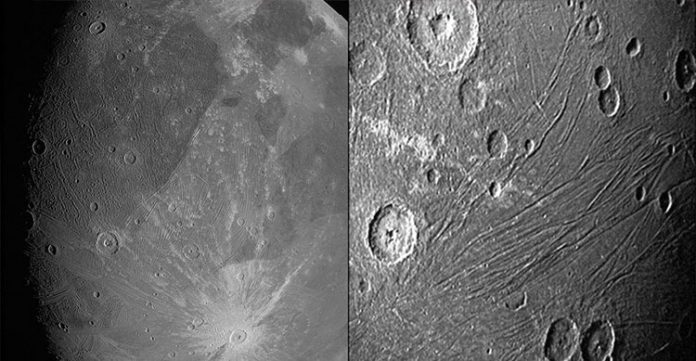NASA’s Juno spacecraft has sent back two new images that offer dramatic glimpses of the icy orb. This comes after the Juno spacecraft has been flying closer to Jupiter’s largest moon for more than two decades.
Juno Spacecraft Releases Pictures of Ganymede
As per the latest reports, Juno came within 645 miles (1038 kilometers) of the surface of Jupiter’s largest moon named Ganymede. The spacecraft then took two images from the Jupiter orbiter’s JunoCam imager from its Stellar Reference Unit star camera.
The photos show the surface of Ganymede in remarkable detail, including craters, clearly distinct dark and bright terrain, and long structural features possibly linked to tectonic faults.
ALSO READ: Elon Musk SpaceX To Send Two Astronauts To Moon After Over 50 Years; Wins…
Juno Principal Investigator Scott Bolton of the Southwest Research Institute in San Antonio said in a statement that this is the closest any spacecraft has ever come to the mammoth moon in a generation. He added that they are further going to take their time before they come for any scientific conclusions/ But until then, they are marveling over the celestial wonder.
JunoCam Captured Water-Ice-Encrusted Moon
Reports suggest that the using the green filter installed in the JunoCam visible-light imager captured almost an entire side of the water-ice-encrusted moon. Later, when versions of the same image come down incorporating the camera’s red and blue filters, imaging experts will be able to provide a colour portrait of Ganymede. Image resolution is about 0.6 miles (1 kilometer) per pixel.
ALSO READ:NASA Receives Martian Winds Sounds From Perseverance Rover
Furthermore, Juno’s Stellar Reference Unit which is a navigation camera that keeps the spacecraft on the course provided a black and white picture of Ganymede’s opposite side of the sun. Image resolution is between 0.37 to 0.56 miles (600 to 900 meters) per pixel.
The spacecraft will send more images from its Ganymede flyby in the coming days.
The solar-powered spacecraft’s encounter with the Jovian moon is expected to yield insights into its composition, ionosphere, magnetosphere. Along with ice shell while also providing measurements of the radiation environment that will benefit future missions to the Jovian system.







